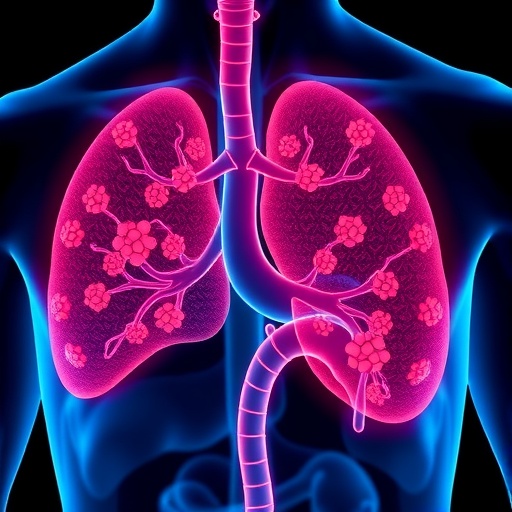
A groundbreaking new study published in BMC Cancer explores the intricate challenges of diagnosing and prognosticating alpha-fetoprotein (AFP)-negative hepatocellular carcinoma (HCC), a subset of liver cancer cases that notoriously evade early detection due to their lack of elevated AFP levels. The research presents compelling evidence that serum glypican-3 (GPC3) and protein induced by vitamin K absence or antagonist II (PIVKA-II) serve as potent biomarkers, offering fresh hope in the timely identification and outcome prediction of this elusive cancer form.
Hepatocellular carcinoma remains one of the most lethal malignancies worldwide, with its prognosis heavily reliant on early detection. Traditionally, AFP has been the cornerstone biomarker guiding clinicians. However, 20 to 40 percent of HCC patients do not exhibit increased AFP levels, posing a significant hurdle to accurate diagnosis. These AFP-negative cases necessitate novel diagnostic approaches, an urgent clinical demand this study boldly addresses through a sophisticated analysis of GPC3 and PIVKA-II serum markers.
Glypican-3, a heparan sulfate proteoglycan prevalent in embryonic tissues, but typically absent in healthy adult liver, re-emerges in cancerous liver cells, positioning it as a promising biomarker. Similarly, PIVKA-II, an abnormal form of prothrombin arising under conditions of vitamin K insufficiency, has shown elevated serum levels in patients with HCC. While prior studies hinted at their diagnostic potential, this research meticulously quantifies their sensitivity and specificity within AFP-negative cases, thus refining their clinical relevance.
The investigators embarked on a robust case-control study measuring serum GPC3 and PIVKA-II levels in a cohort of untreated AFP-negative HCC patients compared to AFP-negative benign liver disease controls. Employing receiver operating characteristic (ROC) curve analysis reinforced that PIVKA-II outperforms GPC3 individually, with sensitivities and specificities surpassing 80 percent. However, rather than relying on single biomarkers, the study innovatively integrates GPC3, PIVKA-II, and gamma-glutamyltransferase (GGT) into a comprehensive diagnostic nomogram, elevating the area under the curve (AUC) to an impressive 0.943.
This novel diagnostic nomogram attested to a remarkable 95.2 percent sensitivity and 81.7 percent specificity in distinguishing AFP-negative HCC from benign liver diseases, a game-changing advance. These findings underscore the synergistic value of combining multiple biomarkers and routine liver enzymes, enhancing clinical precision beyond existing tests. Early-stage cancers and small tumor sizes were notably detected with improved accuracy, a critical factor in improving patient outcomes.
In parallel to diagnosis, the prognostic utility of GPC3 and PIVKA-II was rigorously investigated. Utilizing restricted cubic spline models, patients were stratified into high-risk and low-risk groups based on serum cutoff values—0.124 ng/mL for GPC3 and 274 mAU/mL for PIVKA-II—which correlated significantly with survival outcomes. This risk stratification approach represents a leap forward in personalized medicine, guiding clinical decision-making by predicting patient trajectories more reliably than AFP alone.
The research team further developed a prognostic nomogram incorporating five pivotal variables: high-risk GPC3 expression, cirrhosis status, albumin levels, presence of portal venous thrombosis (PVT), and surgical treatment history. This multivariate Cox regression-based model was adept at delineating patients with markedly different survival probabilities, thus facilitating tailored therapeutic strategies and follow-up regimens.
Intriguingly, this multi-parametric prognostic model not only leverages serum biomarkers but also incorporates clinical indicators, acknowledging the complexity of tumor biology and host interactions. Portal venous thrombosis, a known adverse prognostic factor, and hypoalbuminemia reflecting liver function reserve, enhance the nomogram’s clinical relevance. Surgical intervention status further complements the prognostic equation, Spotlighting integrated patient management.
From a methodological standpoint, the study’s rigorous statistical approach adds credence to its findings. The use of LASSO regression enabled efficient variable selection, minimizing overfitting in the nomogram development. Subsequent validation via ROC curve analyses and decision curve analysis (DCA) confirmed the robust predictive capacity and clinical utility of both diagnostic and prognostic models.
Beyond immediate clinical implications, this research shines a spotlight on the evolving landscape of biomarker discovery in oncology. The identification and validation of novel serum markers like GPC3 and PIVKA-II hold the promise of transforming HCC management, especially for AFP-negative populations who have historically faced diagnostic ambiguity and poor outcomes due to delayed intervention.
Biologically, GPC3’s re-expression in malignant hepatocytes raises intriguing questions regarding its role in tumorigenesis and potential as a therapeutic target. Likewise, PIVKA-II’s elevation reflects complex alterations in vitamin K metabolism and coagulation pathways within the cancer milieu. The intersection of these molecular pathways with tumor biology signals fertile ground for future translational research.
Clinicians and researchers are poised to benefit from these insights, with the nomogram tools providing accessible, evidence-based frameworks to augment clinical assessments. The practical application of such models in standard clinical workflows could dramatically improve early detection rates and prognostication, culminating in better personalized care and potentially increased survival rates for patients with AFP-negative HCC.
Nevertheless, the authors acknowledge the study’s limitations, including the single-center design and relatively modest sample size. They advocate for larger multicentric validation cohorts and exploration of additional biomarkers to further refine the models. Integration with imaging and genomic profiling also emerges as a promising avenue to enhance precision oncology in liver cancer.
In conclusion, this landmark study establishes serum GPC3 and PIVKA-II as invaluable biomarkers for the diagnosis and prognosis of AFP-negative hepatocellular carcinoma. The well-calibrated nomogram prediction models derived from these markers present a pivotal advance, offering clinicians powerful tools to overcome diagnostic challenges, stratify risk accurately, and personalize treatment strategies. As liver cancer continues to impose a global health burden, such innovations herald a new era toward improved outcomes for previously underserved patient subsets.
The translational impact of these findings transcends diagnostic advancements, inspiring future therapeutic developments targeting GPC3 and PIVKA-II pathways. Together with ongoing advances in systemic therapies and surgical techniques, this biomarker-based paradigm may redefine the clinical landscape of hepatocellular carcinoma management.
As the medical community seeks to outpace the stealthy progression of AFP-negative HCC, the integration of serum GPC3 and PIVKA-II within nomogram frameworks stands as a beacon of progress—offering timely, accurate, and clinically actionable insights essential to saving lives in the battle against liver cancer.
—
Subject of Research: Diagnostic and prognostic evaluation of serum glypican-3 (GPC3) and protein induced by vitamin K absence or antagonist II (PIVKA-II) in AFP-negative hepatocellular carcinoma, including development of nomogram prediction models.
Article Title: Diagnostic and prognostic performance of serum GPC3 and PIVKA-II in AFP-negative hepatocellular carcinoma and establishment of nomogram prediction models
Article References: Lin, Y., Ma, Y., Chen, Y. et al. Diagnostic and prognostic performance of serum GPC3 and PIVKA-II in AFP-negative hepatocellular carcinoma and establishment of nomogram prediction models. BMC Cancer 25, 721 (2025). https://doi.org/10.1186/s12885-025-14025-y
Image Credits: Scienmag.com
DOI: https://doi.org/10.1186/s12885-025-14025-y
Tags: AFP-negative hepatocellular carcinomaalpha-fetoprotein negative casesbiomarkers for liver cancerchallenges in diagnosing liver cancerearly detection of liver cancerglypican-3 as a cancer biomarkerimproving liver cancer prognosisliver cancer research advancementsnovel diagnostic approaches for cancerPIVKA-II in liver cancer diagnosisprognostic markers for HCCserum markers for hepatocellular carcinoma


